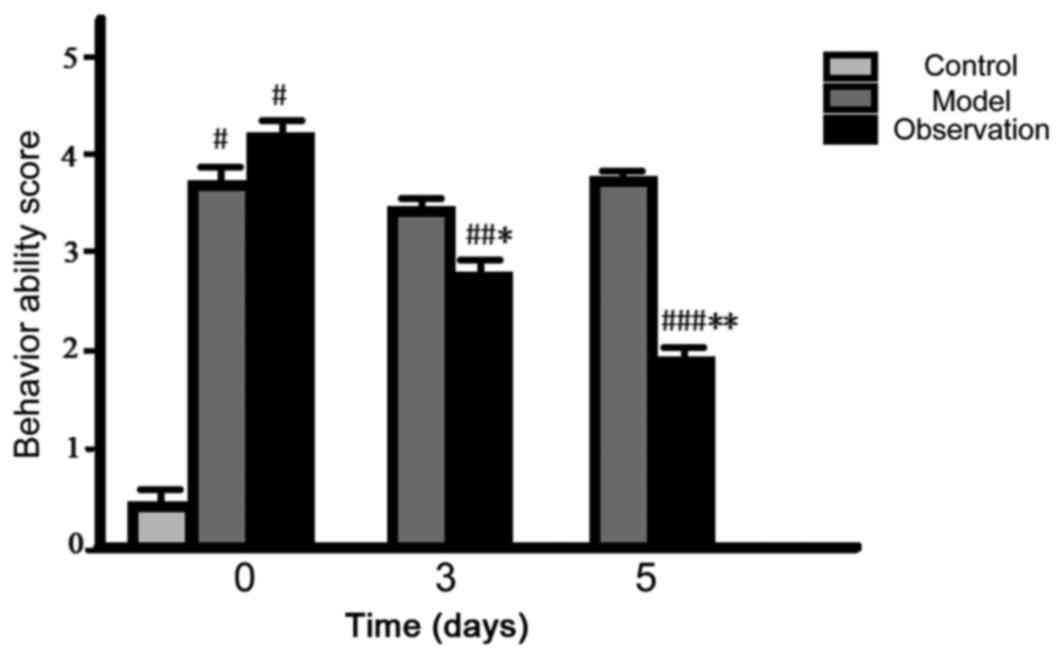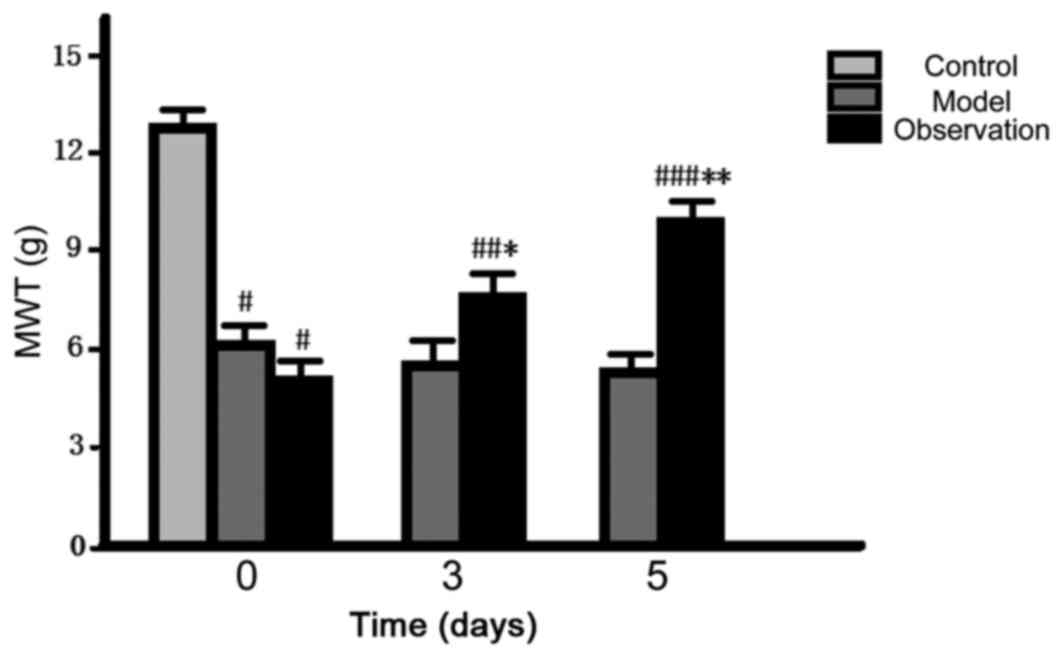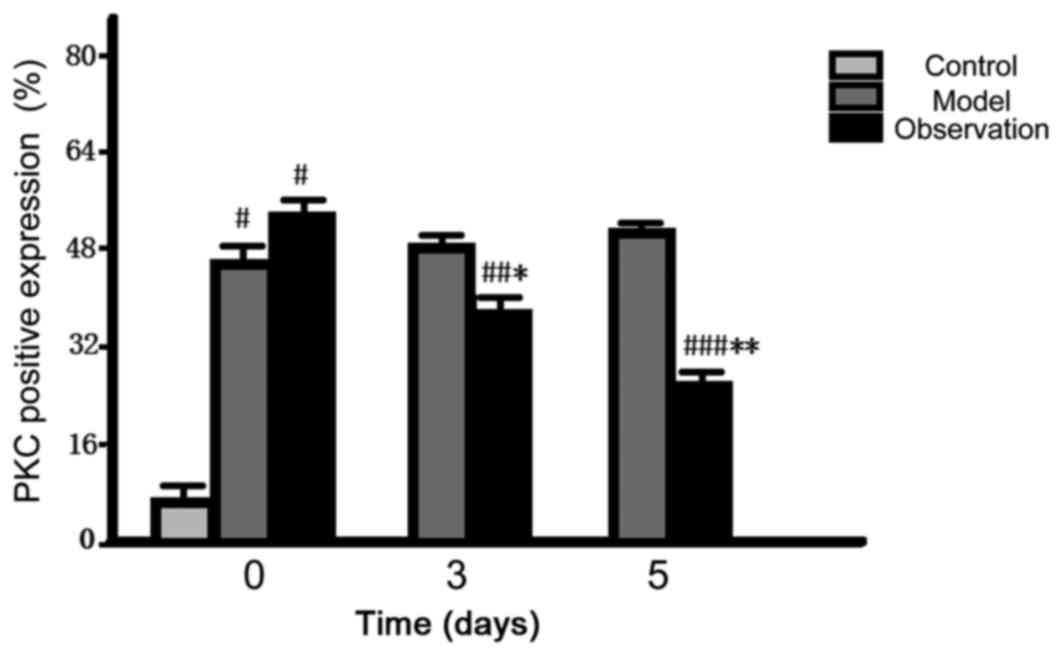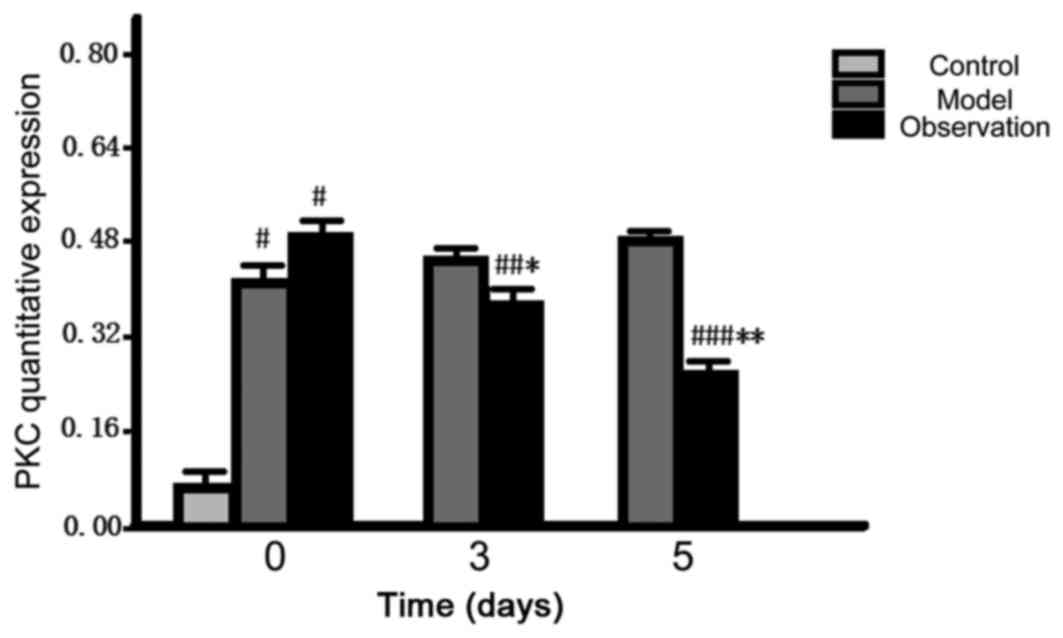Influence of intrathecal injection with dexmedetomidine on the behavioral ability and analgesic effects on rats with neuropathic pain and expression of protein kinase C in the spinal dorsal horn
- Authors:
- Published online on: August 29, 2018 https://doi.org/10.3892/etm.2018.6664
- Pages: 3835-3840
-
Copyright: © Li et al. This is an open access article distributed under the terms of Creative Commons Attribution License.
Abstract
Introduction
As an important signal transduction molecule in cells of the spinal dorsal horn, protein kinase C (PKC) has an extremely complex biological function. It is also distributed widely throughout the body and many studies (1,2) have verified that it has a close relationship with pain-induced mechanisms. It plays an important role in pain-induced inflammatory factor adjustment along afferent and efferent nerves and in the expression of multiple targeting proteins. Dexmedetomidine is an adrenergic receptor stimulant with high α2 specificity that was discovered recently, which features less interference for systemic hemodynamics, weak respiratory depression effects, increased responsiveness, stable pharmacokinetics in vivo, as well as high bioavailability. Dexmedetomidine also has anxiolytic, anticonvulsion and anti-epileptic effects, and it has become one of the primary narcotic and adjuvant drugs in clinic usage, with a wide application potential (3,4). Some researches (5,6) have pointed out that dexmedetomidine has a certain analgesic effect on chronic neuropathic pain, but its related mechanism has not been elucidated yet. Therefore, this study aimed to estimate the influence of intrathecal injection of dexmedetomidine on the behavioral impact and analgesic effect in rat models with chronic neuropathic pain, as well as the role that the expression of PKC in the spinal dorsal horn plays in the analgesic mechanisms of dexmedetomidine. It is hypothesized that the results of this study may provide a frame of reference for the approach, dosage and effect of dexmedetomidine when applied in chronic neuropathic pain.
Materials and methods
Experimental animals
A total of 35 heathy and clean adult male Sprague Dawley rats were selected, which were bought from Shanghai Bioengineering Animal Experimental Center (Shanghai, China), with their weight ranging from 200 to 250 g. The rats had a free diet and were kept in an environment with temperatures ranging from 22 to 25°C, humidity of about 55% and a day-night ratio of 1:1. After adapting to the environment for a week, the rats were allocated into experimental grouping. Five rats were randomly chosen as the blank control group and the rest were prepared as experimental models with chronic constriction injury, which were randomly divided into the the model and observation groups which received treatment (n=15, each group).
The study was approved by the Ethics Committee of The First Affiliated Hospital of Zhengzhou University (Zhengzhou, China).
Preparation for models with chronic neuropathic pain
After successful anesthesia by intraperitoneal injection with pentobarbital sodium (40 mg/kg), the rats were fixed in lateral position and had their skin cut along the thighbone, 1 cm away from the femoral inferior segment. Blunt dissection was applied to completely expose the right sciatic nerve and the surrounding tissues, approximately 8 mm before free main trunk and bifurcation. Chromium-infused catgut was used to ligature the sciatic nerve 4 times from a position 2 mm away from the nerve initial point, with a space of 1 mm between two tunnels. Normal saline was injected locally for washing, and then the muscle, fascia, subcutaneous tissue and skin were sutured interruptedly. When some certain behaviors, including paw withdrawal and tail licking appeared in the rats, the positive reaction of pain was accepted as the standard for successful modeling.
Experimental methods
The observation group was injected with 10 µl dexmedetomidine intrathecally, while the model group was injected with the equivalent amount of saline. Behavioral outcomes were evaluated by a cumulative and a motor function score at the time of injection, and then 3 and 5 days afterwards. In addition, mechanical withdrawal threshold (MWT) and thermal withdrawal latency (TWL) were applied for the determination of pain threshold. Immunohistochemistry staining method was used to test the positive expression of PKC in the spinal dorsal horn and western blot analysis was used for detection of the PKC quantitative levels of expression.
Intrathecal injection
Two hours after preparing the models, the rats inhaled 3% isoflurane for anesthesia and were fixed in a prone position. L3-L4 space was chosen as the cut location and the length of longitudinal incision was 3 cm, while the muscle tissue was separated by blunt separation, with exposure of the L3-L4 crest space. A 25G needle was then used to penetrate the ligamentum flavum and the spinal dura mater, with puncture success being indicated by the discharge of cerebrospinal fluid. A catheter was inserted slowly for 8 cm through the spinal dura mater and the open end was fixed on L1-L2, while the other end was extracted from the neck and back through a subcutaneous tunnel, with 2 cm exposed for tube occlusion and fixation. When the anesthesia lost efficacy, the rats were injected with 10 µl dexmedetomidine or normal saline. Successful anesthesia was indicated if two legs were not load bearing, without an escape reaction within 10 sec and recovery after 20 min.
Detection methods
Behavior ability score: A cumulative score method was calculated according to the hindpaw touchdown and load level of rats, with hindpaw oppression whitening representing load bearing. A score of 2 meant that the hindpaw did not touch the ground and bore no load; 1, indicated that the hindpaw did not bear load but could touch the ground; and 0, meant that the hindpaw touched the ground and bore a load. An interval of 5 min was applied for each scoring. The final cumulative score was the accumulation of difference in score values between the operative and the healthy side within 1 h. In terms of motor function score, a score of 0 showed that motor function did not change and the rats could walk normally; 1, indicated a mild limitation of motor function, and plantar stimulation could result in normal paw withdrawal; 2, demonstrated that autonomic movement ability was weakened, with a moderate limitation of motor function; the rats could walk normally, but paw withdrawal response caused by plantar stimulation declined; and 3, meant that autonomic movement was completely limited and the rats could not walk, with obvious paw pull phenomenon and no response to plantar stimulation.
Pain threshold detection
The rats were placed on a metal grid by MWT and covered by organic glass shade. The grid was raised and, after 3 min was allotted for adaptation, a fiber threadlet was used to vertically stimulate the middle part of rats' pelma from below, with continuous increases in stimulation intensity. The stimulus thresholds were recorded when leg lift and licking of feet was observed. Each rat was measured 5 times, with an interval of 2 min between measures, to obtain the average. The rats were placed in an organic glass box by TWL, which was put on the glass plate. After 3 min for adaptation, an infrared light beam was directed toward the middle planta of the rats' operation side, until escape behavior was observed. The basic intensity of thermal stimulus was set at 10 sec and automatic cutout configured at 20 sec. Each rat was measured 5 times, with an interval of 2 min, to obtain an average time.
Immunohistochemical staining method
Tissue sections of the spinal dorsal horn were prepared conventionally to a thickness of 5 µm, and with xylene dewaxing, gradient ethanol hydration and antigen retrieval. Three per cent H2O2 solution was added and the sample was incubated for 20 min under 27°C and then a normal goat serum working solution was applied and it was incubated for another 20 min under 27°C. Rabbit anti-mouse PKC monoclonal antibody (dilution, 1:2,000; cat. no. AF1576; Jiangsu Beyotime Science and Technology Ltd., Jiangsu, China) was applied, which was placed in a wet box set at 4°C and kept overnight for incubation. Immunoglobulin G (IgG) from normal rats replaced the primary antibody as a negative control. Goat anti-rabbit IgG polyclonal antibody (dilution, 1:500; cat. no. A0208, Jiangsu Beyotime Science and Technology Ltd.) was applied, which was put in the wet box at 27°C and incubated for 20 min. Horseradish peroxidase was added to mark the streptavidin working solution (Jiangsu Beyotime Science and Technology Ltd.), which was put in the wet box and incubated for 20 min under 27°C, with 5 min of phosphate-buffered saline (PBS) vibration and washing carried out three times. DAB coloration, hematoxylin redyeing, hydrochloric acid alcohol differentiation, ammonium hydroxide blue, dehydration of gradient ethanol, xylene transparency, neutral balsam sealing, airing in room temperature and observation under optical microscope (Olympus, Tokyo, China) were then conducted sequentially. The results were as follows: The semi-quantitative method was applied according to the staining intensity and proportion of stained cells. The yellow staining of cytoplasm or karyon became dark brown, which was regarded as positive. As for staining intensity, a score of 0 indicated no positive staining; 1, indicated weak staining; 2, indicated moderate intensity staining; and 3, indicated strong staining. The ratio of positive cells ≤5% was designated as a score of 0; 6–25% as 1; 26–50% as 2; 51–75% as 3; and >75% as 4. The arithmetic product between two scores of 0–3 represented a negative and 4–12 represented a positive outcome.
Western blot analysis
RIPA lysate was added to the tissue homogenate of spinal dorsal horn tissue and total cellular protein was extracted. Coomassie brilliant blue method was conducted for rough ration. Before detection of protein content, antibody β-actin was applied for protein dosage standardization detection of each sample. A total of 30 µg total protein was selected to proceed with electrophoretic separation using 8% SDS-PAGE and the separation zone was transferred to a polyvinylidene fluoride membrane, with the addition of mouse anti-rat PKC monoclonal antibody (dilution, 1:2,000; cat. no. P5704; Sigma-Aldrich; Merck KGaA, Darmstadt, Germany) and left overnight. Then, rabbit anti-mouse polyclonal secondary antibody (dilution, 1:500; cat. no. SAB3701221 Sigma-Aldrich; Merck KGaA) was added and incubated for 4 h, with PBS washing and ECL coloration. The results were scanned and saved, and gel-imaging software Lab Works4.5 (Invitrogen; Thermo Fisher Scientific, Inc., Waltham, MA, USA) was used for semi-quantitative analysis, which was visualized using integral optical density.
Statistical analysis
Software SPSS 20.0 (IBM Corp., Armonk, NY, USA) was applied for statistical analysis and measurement data was presented as mean ± standard deviation (SD). Single-factor analysis ANOVA was used for the comparison of data among three groups, and t-test was applied for the comparison of data between two groups. Comparisons of data obtained at different time points were conducted using variance analysis of overall measurement. A P<0.05 was considered to indicate a statistically significant difference.
Results
Comparison of behavior ability core
After preparing the models, the initial cumulative and motor function score of the model and the observation group increased and the differences were statistically significant (P<0.05). The values of the cumulative and motor function score for 3 and 5 days decreased in the observation group (P<0.05), while the values of the model group did not change noticeably (P>0.05) (Figs. 1 and 2).
Comparison of pain threshold
After preparing the models, the initial values of MWT and TWL of the model and the observation group decreased and the differences were statistically significant (P<0.05). When it came to 3 and 5 d, the values of MWT and TWL of the observation group gradually increased (P<0.05), but there was no noticeable change in the model group (P>0.05) (Figs. 3 and 4).
Comparison of PKC positive expression in spinal dorsal horn
After preparing the models, the initial positive expression of PKC in the spinal dorsal horn of the model and the observation group rose dramatically and the differences were statistically significant (P<0.05). As for the data at 3 and 5 d, the positive expression of the observation group reduced gradually (P<0.05); however, there was no change in the model group (P>0.05) (Fig. 5).
Comparison of PKC quantitative expression levels in spinal dorsal horn
After preparing the models, the initial quantitative expression level of PKC in the spinal dorsal horn of the model and the observation group rose dramatically and the differences were statistically significant (P<0.05). As for the data at 3 and 5 d, the quantitative expression levels in the observation group reduced gradually (P<0.05); however, there was no change in the model group (P>0.05) (Fig. 6).
Discussion
PKC belongs to a group of phospholipid-dependent enzymes, which can be activated by Ca2+. Activated PKC participates in many biological effects, such as cell proliferation, apoptosis, skelemin remodeling, ion channel and others (7). PKC plays an important role as a secondary messenger in the central nervous system conduction. External stimulus signals or ligand molecules combine with NMDA receptors to activate Ca2+ channels, leading to continuous gathering of Ca2+ in cells. After combining with Ca2+, the conformation of PKC changes, the catalytic area starts and PKC is activated (8). Pain can stimulate nerves and release substance P, which activates the spinal dorsal horn NK1 receptor, which then activates phospholipase C. After hydrolyzing the phospholipid composition of the neuron membrane, diacylglycerol is released, which is a recognized potent activating factor for PKC (9). A study (10) has shown that PKC positive cells are distributed mainly among the superficial layer of the spinal dorsal horn, and are involved in the signal transmission of the central nervous system damage and the adjustment of the central sensitization mechanism. Overall, there are 12 subtypes of PKC in animals whose functions and structures vary from each other (11).
In the central nervous system, dexmedetomidine has an effect on the locus coeruleus nucleus and plays an important role in sedation and hypnosis via antagonism of the sympathetic nerve activity under the combined action of the central and peripheral neurotransmitters (12). A research study (13) has indicated that dexmedetomidine could inhibit the activity of the signal transduction pathway of the dorsal horn neurons, decrease Ca2+ influx and reduce the release of neurotransmitters. Presently, dexmedetomidine is widely used in perioperative anesthesia and postoperative analgesia. In addition, it also has benefits in reducing postoperative cognitive impairment (14). According to the findings of this study, it was concluded that, after preparing the models, the initial cumulative and motor function score of the model and observation groups increased, while the values of MWT and TWL decreased. This suggests that the behavior ability and pain threshold of rats with chronic neuropathic pain has changed. When it came to 3 and 5 days, the cumulative and motor function score of the observation group gradually declined, while the values of MWT and TWL gradually increased. However, there was no obvious change in the model group. This indicates that dexmedetomidine may improve the behavior ability of rats with chronic neuropathic pain and increase the pain threshold. Our further experiments showed that after preparing the models, the initial positive expression of PKC in the spinal dorsal horn of the model and observation groups rose dramatically, and the quantitative expression level in the observation group was also on the rise. As for the data from 3 and 5 days, the positive and quantitative expression levels in the observation group were reduced gradually. However, there was no notable change in the model group. Therefore, we consider that intrathecal injection with dexmedetomidine may improve the behavioral ability of rats with chronic neuropathic pain and decrease their pain level, an effect that may be associated with the inhibition of PKC expression in the spinal dorsal horn.
Some studies have also supported the theory that the aberration of dexmedetomidine could be realized by inhibiting the apoptosis levels of the spinal dorsal horn neurons (15). By activating the α2 adrenergic receptor, dexmedetomidine may inhibit the reaction of the central nervous system, reduce the release of noradrenaline and thereby decrease the stress reaction of organism, so as to generate the effects of analgesia, sedation and antianxiety (16). This sedation effect simulates normal sleep, which implies a state from which one can be readily awoken. The novel findings of this study lie in providing a frame of reference for approaches in the medical application, dosage and effects of dexmedetomidine in treating chronic neuropathic pain. However, it did not thoroughly analyze the expression levels and the effects and actions of the different PKC subtypes. Furthermore, due to limitations of time in the present study, the potential long-term intervention effects of chronic neuropathic pain also require further verification.
Acknowledgements
Not applicable.
Funding
No funding was received.
Availability of data and materials
The datasets used and/or analyzed during the current study are available from the corresponding author on reasonable request.
Authors' contributions
XL helped with the immunohistochemical staining. WZ performed the western blot analysis. Both authors have read and approved the final manuscript.
Ethics approval and consent to participate
The study was approved by the Ethics Committee of The First Affiliated Hospital of Zhengzhou University (Zhengzhou, China).
Patient consent for publication
Not applicable.
Competing interests
The authors declare that they have no competing interests.
References
|
Ritter DM, Ho C, O'Leary ME and Covarrubias M: Modulation of Kv3.4 channel N-type inactivation by protein kinase C shapes the action potential in dorsal root ganglion neurons. J Physiol. 590:145–161. 2012. View Article : Google Scholar : PubMed/NCBI | |
|
Yan X, Yadav R, Gao M and Weng HR: Interleukin-1beta enhances endocytosis of glial glutamate transporters in the spinal dorsal horn through activating protein kinase C. Glia. 62:1093–1109. 2014. View Article : Google Scholar : PubMed/NCBI | |
|
Garrity AG, Botta S, Lazar SB, Swor E, Vanini G, Baghdoyan HA and Lydic R: Dexmedetomidine-induced sedation does not mimic the neurobehavioral phenotypes of sleep in sprague dawley rat. Sleep. 38:73–84. 2015. View Article : Google Scholar : PubMed/NCBI | |
|
Funai Y, Pickering AE, Uta D, Nishikawa K, Mori T, Asada A, Imoto K and Furue H: Systemic dexmedetomidine augments inhibitory synaptic transmission in the superficial dorsal horn through activation of descending noradrenergic control: An in vivo patch-clamp analysis of analgesic mechanisms. Pain. 155:617–628. 2014. View Article : Google Scholar : PubMed/NCBI | |
|
Xu B, Zhang WS, Yang JL, Xu H, Deng XM and Zhang YQ: Dexmedetomidine blocks thermal hyperalgesia and spinal glial activation in rat model of monoarthritis. Acta Pharmacol Sin. 31:523–530. 2010. View Article : Google Scholar : PubMed/NCBI | |
|
Hwang W, Lee J, Park J and Joo J: Dexmedetomidine versus remifentanil in postoperative pain control after spinal surgery: A randomized controlled study. BMC Anesthesiol. 15:212015. View Article : Google Scholar : PubMed/NCBI | |
|
Velázquez KT, Mohammad H and Sweitzer SM: Protein kinase C in pain: Involvement of multiple isoforms. Pharmacol Res. 55:578–589. 2007. View Article : Google Scholar : PubMed/NCBI | |
|
Bu F, Tian H, Gong S, Zhu Q, Xu GY, Tao J and Jiang X: Phosphorylation of NR2B NMDA subunits by protein kinase C in arcuate nucleus contributes to inflammatory pain in rats. Sci Rep. 5:159452015. View Article : Google Scholar : PubMed/NCBI | |
|
Kim JYV, Tillu DV, Quinn TL, Mejia GL, Shy A, Asiedu MNK, Murad E, Schumann AP, Totsch SK, Sorge RE, et al: Spinal dopaminergic projections control the transition to pathological pain plasticity via a D1/D5-mediated mechanism. J Neurosci. 35:6307–6317. 2015. View Article : Google Scholar : PubMed/NCBI | |
|
Mo G, Grant R, O'Donnell D, Ragsdale DS, Cao CQ and Séguéla P: Neuropathic Nav1.3-mediated sensitization to P2X activation is regulated by protein kinase C. Mol Pain. 7:142011. View Article : Google Scholar : PubMed/NCBI | |
|
Melemedjian OK, Tillu DV, Asiedu MN, Mandell EK, Moy JK, Blute VM, Taylor CJ, Ghosh S and Price TJ: BDNF regulates atypical PKC at spinal synapses to initiate and maintain a centralizedchronic pain state. Mol Pain. 9:122013. View Article : Google Scholar : PubMed/NCBI | |
|
Wu X, Hang LH, Wang H, Shao DH, Xu YG, Cui W and Chen Z: Intranasally administered adjunctive dexmedetomidine reduces perioperative anesthetic requirements in general anesthesia. Yonsei Med J. 57:998–1005. 2016. View Article : Google Scholar : PubMed/NCBI | |
|
You HJ, Lei J, Xiao Y, Ye G, Sun ZH, Yang L and Niu N: Pre-emptive analgesia and its supraspinal mechanisms: Enhanced descending inhibition and decreased descending facilitation by dexmedetomidine. J Physiol. 594:1875–1890. 2016. View Article : Google Scholar : PubMed/NCBI | |
|
Ni J, Wei J, Yao Y, Jiang X, Luo L and Luo D: Effect of dexmedetomidine on preventing postoperative agitation in children: A meta-analysis. PLoS One. 10:e01284502015. View Article : Google Scholar : PubMed/NCBI | |
|
Eskandr A and Maseeh SA: The effect of dexmedetomidine on lumbar epidural injection for failed back surgery syndrome. Anesthesiol Res Pract. 2016:71980482016.PubMed/NCBI | |
|
Iirola T, Aantaa R, Laitio R, Kentala E, Lahtinen M, Wighton A, Garratt C, Ahtola-Sätilä T and Olkkola: Pharmacokinetics of prolonged infusion of high-dose dexmedetomidine in critically ill patients. Crit Care. 15:R2572011. View Article : Google Scholar : PubMed/NCBI |















